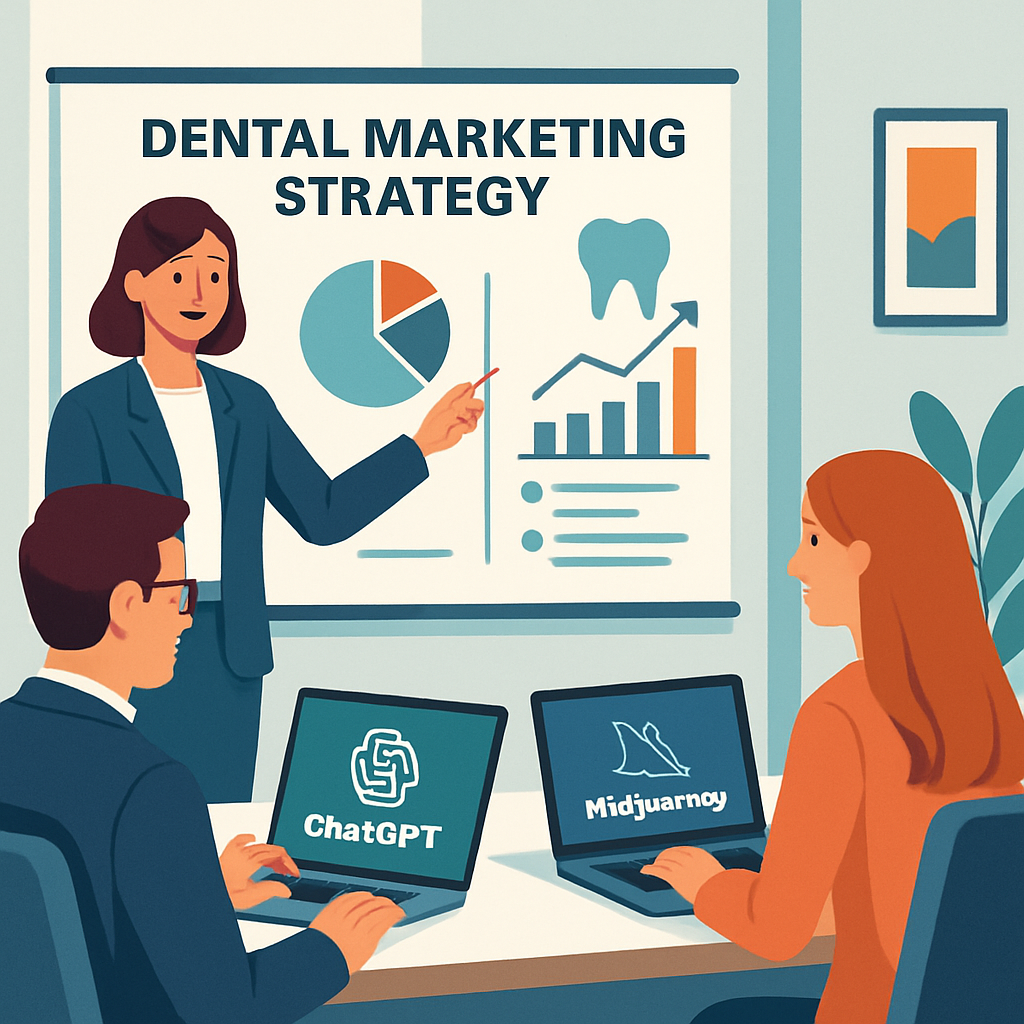December 26, 2025
12 min
Discover how to balance data privacy with effective analytics in dental practices while ensuring compliance and building patient trust.
August 18, 2025
12 minutes
This comprehensive guide explores how AI-driven marketing helps dentists improve ROI. Learn key benefits, tools, case studies, and strategies to boost patient acquisition, retention, and practice growth.

In the landscape of modern business, you don’t get far unless you’re sharp about technology. Nowhere is this more obvious than in digital marketing. Even the most traditional industries—like dentistry—are feeling the shift. AI-driven marketing isn’t just a new lever for growth, it’s fast becoming the lever. Dentists who know how to wield it aren’t just playing catch-up; they’re setting the pace. If you want to see real, leveraged ROI in your practice, this essay will show you how AI can be a force-multiplier—rearranging not just your marketing campaigns, but the entire experience of being your patient.
Let’s back up. What does “AI-driven marketing” really mean when you’re running a dental practice? At its core, it’s about offloading what humans do badly—think data crunching, pattern spotting, and predictively personalizing—onto machines that are better at it. Machine learning and AI let you analyze vast lakes of data, predict who’s about to need a teeth cleaning, and tailor communication in a way that feels like a practiced (and always energetic) concierge. In recent years, LLMs (Large Language Models) like ChatGPT and image generators like Midjourney have leapfrogged static automation. Used properly, they don’t just automate—they synthesize and surprise.
If there’s a superpower in AI, it’s the ability to see patterns humans can’t. Platforms like IBM Watson Analytics churn through marketing data and spit out not just reports but insights: what’s working, what’s not, what’s about to fail, and who will likely respond to your new whitening campaign. The point isn’t just measuring; it’s acting strategically, always a step or two ahead of the market.
Measured by outcomes, the consensus from dental marketing experts is clear: practices using AI see more engaged patients and less wasted motion. Bots don’t forget to follow up, don’t take sick days, and can suggest the right time to book that next appointment. The premium isn’t just on efficiency—it’s on shaping an experience that keeps patients around, differentiating the practice, and making competition play catch-up.
1) Personalized marketing campaigns: Why spray and pray when you can target with sniper-like precision? With every data point, AI turns the generic newsletter into a tailored whisper: timely, specific, and far more likely to convert. You get a feedback loop—patients click, AI refines the pitch, responses improve in a virtuous cycle that humans just can’t match manually.
2) Enhanced patient engagement and satisfaction: Nobody likes being put on hold. AI-powered interfaces—chatbots and virtual assistants—answer instantly, even after hours. The surface effect is higher satisfaction. The deeper effect is trust, built as patients start to feel you’re always listening, always responding.
3) Streamlined operations and increased efficiency: You don’t go to school to become a dentist only to spend half your day on logistics. AI handles the tedium: appointments, reminders, follow-ups. Automation cuts error rates, saves time, and lets you focus on patients—where you actually deliver value.
4) Data-driven decision-making for optimized ROI: The dream of marketing is always to do more with less. Marketing ROI analytics for dental practices transform piles of performance data into actionable plans: what works, where to double down, what to drop immediately. The days of “gut feeling” ad spend are over. Efficient allocation means higher ROI—sometimes much higher.
Additionally, practices can adopt AI-driven marketing intelligence for dentists to identify untapped opportunities, benchmark against competitors, and fine-tune campaigns for maximum return.
5) Patient Experience Enhancement: Tools like ChatGPT and Midjourney don’t just operate in the background. They frontload value: articles that answer real patient concerns and visuals that entice without looking generic, keeping your practice top-of-mind and relevant.
6) Cost Efficiency: If you’ve ever tried to hire and retain a seasoned marketing team, you know the pain. AI lets you scale without the headcount—automating campaign management and content creation so that you can run lean without sacrificing quality.

Content generation, personalized messaging, automating responses, engaging social media content. Turns communication into a superpower—automation saves time, tailored content builds connection, and your online presence goes from static to magnetic.
Leveraging ChatGPT for Enhanced Communication
If you’re serious about scaling quality communication, it’s impossible to ignore ChatGPT. In practice, it’s the engine behind seamless reminders, smart follow-up, and always-on answers to patient questions. It churns out blog posts for your audience and keeps your social media stream lively—at a fraction of the effort. Result: more engagement and a perception that your practice is both responsive and resourceful.
Creative design for marketing campaigns, customizable artwork for digital media, high-quality visual content generation. Visuals are the hook. Midjourney hands you professional artwork for campaigns and websites, letting you outshine competitors who still default to stock.
Creating Compelling Visuals with Midjourney
Every practice wants to look good; few have the budget to commission endless custom graphics. Enter Midjourney. It becomes an always-available designer—turning raw ideas into sharp visuals that match your voice. With little friction, you get professional-grade output that draws in the patients you want.
Lead management, CRM solutions, marketing ROI analytics, seamless PMS integration. ConvertLens optimizes the nitty-gritty—ad spend, patient conversion, actionable reporting—so that you’re always improving rather than just maintaining.
Optimize Operations with ConvertLens
Too many leads slip through the cracks when processes aren’t tightly managed. ConvertLens is built to capture, track, and convert those leads—with analytics that don’t just report, but recommend. Real ROI analysis, not just metrics for metrics’ sake. Integrate it with your PMS, and you have a feedback machine, tuning itself as it learns what works for you.
Marketing platform, automated processes, patient communication enhancement. Elevates what marketing means: more personalized, more automated, and always measuring what matters to drive decisions.
Streamline Marketing Efforts with Scorpion
Running a practice isn’t just about care—it’s marketing, operations, retention. Scorpion automates a chunk of that, putting intelligent processes in place and keeping communication channels humming. The real win? Their data analysis helps you not just keep up, but to actually get ahead, adapting to changes in what patients want before your rivals do.
You don’t just bolt AI onto the side of your practice and hope it works. Start by sketching sharp objectives: are you after new patient volume, deeper engagement, or smoother operations? Once you’re clear on what matters, pick tools that don’t create more problems than they solve.
Talk about ROI and most people handwave. If you want to know if AI is working, you need to measure backwards from outcomes. Here are the metrics that matter, what you should actually pay attention to as you iterate:
The right tools—ConvertLens, for instance—pull together these measures in near real time, automating reporting and making feedback actionable. Continuous iteration, not static analysis, is the trick, with every change tightening the flywheel of improvement. In a world moving this fast, that’s how practices win.
The golden age of AI is exciting, but it comes with thorns. The two big ones: privacy and people. For privacy, you can’t play fast and loose with patient data—HIPAA and other laws make this a minefield. Transparency isn’t just legally required; it’s the baseline for trust. Your data handling must be robust and up to code.
Then there’s resistance. People don’t like change, sometimes for good reason. Staff worry about being replaced, about complexity. The antidote is persistent, clear training—emphasizing how AI is an amplifier, not a subtractor, and how it can make their jobs less tedious. The best practices foster a vibe of learning—where improvement is the standard, not the exception.
To use AI credibly in a healthcare environment is to recognize that ethical gap between possible and permissible. You want systems free of bias, with guardrails in place so humans always have veto power. As Manny Chopra, D.M.D., from the ADA points out: “human expertise and clinical judgment remain essential.” Let AI run, but always keep the leash handy, with standards set by authorities like the ADA guiding integration.
It’s also your job to audit—AI changes fast, and what worked ethically a year ago may not now. Keep systems under review, always prioritizing patient safety and privacy alongside innovation.
If you think we’ve peaked, think again. Trends like Generative Engine Optimization (GEO) are reshaping how practices show up online. Instead of just aiming for Google rankings, practices will soon have to optimize for AI assistants—where the answer is instant and personalized, giving patients little reason to click elsewhere. The patient journey itself is changing—speeding up, getting smarter, and always measured.
Enhanced Personalization
The algorithms are only getting better at tailoring experiences. Practices will be able to pitch patients not just based on demographics, but on behavior, timing, even mood—hyper-customizing every outreach, every promotion.
Expanding Targeted Marketing Capabilities
Instead of broad campaigns, AI lets you hone in. As analytics sharpen, you’ll deliver messages with precision, cut waste, and find the patients you actually want—before they find you.
Driving Efficiency
The more AI does, the less your team has to. Scheduling, inquiries, admin—these shift from friction points to automated strengths, letting skilled staff focus where it matters: delivering patient care.
Integration of Advanced Algorithmic Solutions
We’re just scratching the surface: sentiment analysis, diagnostic imaging, feedback loops that get smarter. As machine learning gets deeper, the line between care and marketing blurs. Every patient touchpoint becomes a source of insight—and an opportunity to refine the practice.
Challenges and Ethical Considerations
The flip side of this future is that complexity, privacy, and ethics only get harder. Navigating these waters means staying vigilant—integrating best practices, auditing as you go, and never assuming today’s solutions work tomorrow. Only the adaptable thrive.
So, don’t wait to catch up. Think ahead, integrate early, and let AI keep your practice not just current but distinctly ahead of the curve—ready for whatever comes next in the digital dental revolution.
Marketing with AI isn’t about replacing the dentist; it’s about multiplying what’s possible for a practice. With the right approach, you get more engagement, sharper marketing, and a competitive moat that gets deeper the longer you invest. The opportunity isn’t just to keep pace, but to set it. If you’re serious about growth and resilience, now’s the time to build AI into your practice’s DNA.



Sign Up Now & Someone from Our Team Will Be in Touch Shortly!
Use the form below to send us a message, and we’ll get back to you as soon as we can.